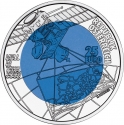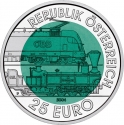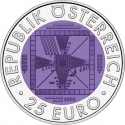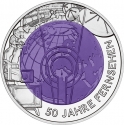You are about to finish your registration. Please check your mailbox (including spam folder). There should be a letter with a confirmation link. Check setting to make sure that your e-mail address is correct.
Send letter againDescription
By 1912 only France held more world flying records than Austria. The beautiful turquoise blue 2007 edition of the 25 euro Silver Niobium series pays tribute to Austria’s magnificent men and their flying machines, as well as to Austria’s contribution to aeronautics.
In 1907, Franz Xaver Wels flew several hundred metres with the kidney-shaped Zanonia glider. Igo Etrich developed the glider into a recognisable airplane called the Taube (the Dove) because of its bird-like wings and tail. With this machine, in 1910 Etrich’s colleague Karl Illner was able to make the first successful motorised flight in Austria, from Wiener Neustadt to Vienna and back.
Each coin contains 9 g of 900 Fine Silver in its outer ring and 6.5 g of 998 pure niobium. Each piece is encapsulated, boxed and comes complete with a numbered certificate guaranteeing its authenticity.
Obverse

|
Depicts an interior view of modern cockpit. REPUBLIK ÖSTERREICH |
|---|---|
Reverse

|
At the very top of the niobium "pill" on the reverse is the Etricht Taube, a monoplane aircraft designed by Austrian flight pioneer Igo Etrich (1879–1967) that was first flown in 1910. Below it is an image of the Zanonia, a glider developed by Etrich in 1903 that was inspired by the flying seed of Zanonia microcarpa, a Javanese plant. A portion of one of its wings extends into the silver ring, while a part of the other wing is concealed by an image of Igo Etrich piloting an aircraft and waving, which also extends from the center into the ring. Etrich's signature is shown superimposed over the body of the plane he is flying, as are the initials of Thomas Pesendorfer. Inscribed around the upper rim of the silver ring is the legend "Aviation in Austria". LUTFAHRT IN ÖSTERREICH |
| Edge |
25 Euro
Silver Niobium Coin
Austrian Aviation
Subscribe series
KM# 3147
Silver Niobium Coin
Austrian Aviation
Characteristics
| Type | Commemorative Issue (Non-circulating) |
| Material | Bi-Metallic |
| Ring | Silver |
| Center | Niobium |
| Weight | 16.5 g |
| Diameter | 34 mm |
| Thickness | 2.55 mm |
| Shape |
|
| Alignment | Medal |
| Mint |
Austrian Mint
|







